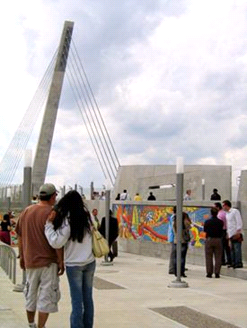Addressing Environmental Justice in the NEPA Process
Environmental Justice (EJ) is grounded in three principles that establish an approach to address the needs of minority and low-income populations in the Federal project planning and development process. The three EJ principles are: 1) ensure that minority and low-income communities do not experience any disproportionately high and adverse impacts from federally funded projects; 2) ensure full and fair participation in the planning process for these projects; and 3) prevent the denial of, reduction in, or delay in the receipt of these projects and programs’ benefits. These principles apply to all aspects of the Federal Highway Administration’s (FHWA) programs and policies, including environmental review through the National Environmental Policy Act (NEPA) of 1969. The law directs Federal agencies to integrate environmental considerations into Federal decisionmaking and to document the analysis of potential impacts on EJ populations. In the transportation arena, FHWA offers guidance to Division Offices, State Departments of Transportation (DOT), and local stakeholders on how to address potential impacts to minority and low-income populations through the environmental review process.

Analysts determined that implementing a toll system on existing freeways would not have disproportionately high and adverse effects on nearby EJ populations. (Courtesy of FHWA)
FHWA recently developed a series of ten case studies that demonstrate effective practices to address EJ as part of the NEPA review process for transportation projects. The following sections feature five case studies that illustrate some of these effective practices. To view the full-length case studies, visit the FHWA’s EJ website.
Effective Practices and Case Studies
Practice #1: Conduct a complete analysis of potential impacts and solutions
The first effective practice is to conduct a complete analysis of potential impacts to EJ communities and possible solutions. In Durham, North Carolina, the North Carolina DOT (NCDOT) proposed widening a one-mile portion of a roadway in a low-income area that is a historically Black/African-American community with an increasing Hispanic/Latino population. The project would reduce congestion and improve safety along the corridor. The initial plans required the removal of the Los Primos Supermarket, which NCDOT had initially determined would not adversely impact the community based on the feedback from Durham’s leaders. Due to some opposition in the community, however, NCDOT interviewed additional community groups, conducted a survey of neighborhood residents at the supermarket, updated demographic information using current census data, and performed a supplemental site-comparison analysis of the current supermarket location and an alternative location five blocks away. The site comparison analysis involved identifying the pedestrian patterns for accessing each location and a detailed assessment of access and visibility, crime, vehicle ownership, and concentrations of EJ communities. This analysis indicated that the removal of the supermarket would indeed adversely affect EJ populations in the area. Because many residents walked to the store, the added distance to the alternative location would be a burden. In the end, NCDOT revised the roadway plan to preserve the supermarket and avoid burdening the community, while still addressing the corridor’s congestion and safety concerns.
Practice #2: Use the cumulative impact assessment during planning to inform NEPA
The second effective practice is to use data and results from a cumulative impact assessment in the planning process to inform and supplement the NEPA process. The Metropolitan Transportation Plan for the Dallas-Fort Worth area, Mobility 2035, contains several proposed tolled roadways. Toll facilities in low-income communities present both burdens and benefits. Low-income populations are least able to afford tolls yet often live close to these facilities and, therefore, can be directly affected by the noise and air pollution generated. On the other hand, tolls can provide congestion relief to the general public, including to low-income populations. In order to determine whether the toll system would place undue burden on the low-income populations, the North Central Texas Council of Governments (NCTCOG), the Texas DOT, and FHWA’s Texas Division Office jointly decided to conduct Texas’ first Regional Tolling Analysis (RTA) during the planning phase. Through the RTA, NCTCOG conducted a cumulative impact assessment to evaluate 16 factors that addressed how the proposed toll facilities could potentially impact low-income residents. Because NCTCOG conducted a cumulative impact assessment during the planning phase in the RTA, much of the information supplemented the cumulative impacts analysis section of the NEPA document, helping to streamline the overall process. In the end, the RTA revealed that implementing the toll systems would not have disproportionately high and adverse impacts on the low-income populations.
Practice #3: Use creativity and innovation when mitigating for all impacts
The third practice is to use community participation and feedback to develop new methods for mitigating impacts of proposed development. In Lexington, Kentucky, the Kentucky Transportation Cabinet (KYTC) proposed the Newtown Pike Extension project to relieve congestion and improve pedestrian access in the central business district. The project would indirectly increase land values, potentially pricing residents out of their neighborhood, thereby negatively impacting the Southend Park area of the Davistown neighborhood, a low-income and minority community. Since the residents expressed concern, KYTC conducted a cumulative impact assessment and identified specific residents that would be directly affected by the project. The cumulative impact assessment included door-to-door surveys of Southend Park residents to better understand their needs as well as collect their thoughts on mitigation options. Through outreach and feedback, KYTC determined that the creation of a Community Land Trust would keep home ownership affordable for the existing low-income households in the neighborhoods. The Community Land Trust would promote housing affordability by enabling residents to own their homes, but not the land. This creative affordable housing mechanism gave residents guaranteed use of the land with a renewable 99-year lease. Since KYTC gave low-income residents the opportunity to participate in the creation of the redevelopment plan, the Agency was able to address the residents’ concerns through the proposed mitigation.

A pedestrian bridge reconnects Mexicantown and integrates community art into the project. (Courtesy of FHWA)
Practice #4: Look for community improvement opportunities as part of projects
The fourth practice highlighted in the case studies is to examine project scopes to identify opportunities to make other associated improvements. The example for this practice comes from Detroit, Michigan. In 1970, the construction of Interstates 75 and 96 divided Mexicantown, a working-class Hispanic/Latino neighborhood. Twenty years later, the Michigan DOT (MDOT) conducted an Environmental Assessment for the Ambassador Bridge Gateway project, which includes a pedestrian bridge that will reconnect Mexicantown. Because of the project’s potential impacts, the community became engaged in every phase of the project. The community’s participation encouraged MDOT to incorporate public art into the new pedestrian bridge by sponsoring a public art competition to select an artist to design a mural and free-standing sculpture near the bridge. Community residents and MDOT staff rallied around the art competition, which fostered trusting relationships between both groups and increased attendance at public meetings. This example highlights the benefits of engaging the affected community to make additional improvements to EJ communities. In this case, the project and its art competition reconnected Mexicantown, while improving community relations and providing new opportunities for public art in the neighborhood.
Practice #5: Use public input to inform every aspect of the EJ analysis
Another effective practice highlighted in the case studies is the use of public outreach techniques to solicit input from the low-income and minority residents to inform EJ analysis. NCDOT proposed updating deteriorating bridges, improving ramps, and resurfacing the roadway along a one-mile section of Business 40, a four-lane roadway through downtown Winston-Salem, NC, to improve safety and reduce congestion. Downtown Winston-Salem has residents at many income levels and some minority populations. The initial Environmental Assessment for the Business 40 project revealed that there were several recently completed and ongoing projects in and around the area. NCDOT recognized that the existing construction and associated closures, delays, and other inconveniences caused frustration in the community. To address these and the potential future impacts associated with the Business 40 project, NCDOT convened an Accelerated Construction Technology Transfer conference to gather input from the Nation’s experts who had experience with similar transportation projects and related impacts. From this collaboration, NCDOT conducted an extensive public outreach effort, which resulted in a public involvement plan that included surveys, meetings, and printed materials to gather input from community members. The public outreach indicated that two-thirds of community members preferred that the construction take place over two years with full closure of a section of Business 40 instead of the other proposed construction alternatives, which included a six-year partial closure. This outcome differed from NCDOT’s initial information about the community’s preferences, which highlights the effectiveness of the outreach.
Incorporating the Effective Practices
The five effective practices gleaned from the case studies can guide transportation practitioners in ensuring that both benefits and burdens of federally funded transportation projects are shared equally among all communities. The highlighted projects demonstrate specific methods used to address EJ as a part of the NEPA review process. In addition, they show that there is no standard approach to identifying and understanding impacts that transportation projects can have on low-income and minority populations. These case studies provide good models for agencies that are considering the incorporation of these practices into their own EJ processes.
Contact Information
Harold Peaks
Office of Project Development and Environmental Review
Federal Highway Administration
(202) 366-1598
harold.peaks@dot.gov
Bruce Bender
Office of Project Development and Environmental Review
Federal Highway Administration
(202) 366-2851
bruce.bender@dot.gov
Look What’s New!
- FHWA recently released guidance on the Transportation Alternatives Program (TAP), which provides funding for programs and projects identified as transportation alternatives, including pedestrian and bicycle facilities and safe routes to school projects, among others. TAP is a program that is funded through the Moving Ahead for Progress in the 21st Century Act (MAP-21). Click here for more information.
- FHWA also released interim guidance on Congestion Mitigation and Air Quality (CMAQ) Operating Assistance under MAP-21. Click here for more information.
Successes in Stewardship is a Federal Highway Administration newsletter highlighting current environmental
streamlining and stewardship practices from around the country. Click here to subscribe to the newsletter, or call 617-494-2092 for more information.

